Operation Shader
Operation Shader is the operational code name given to the contribution of the United Kingdom in the ongoing military intervention against the Islamic State of Iraq and the Levant. The operation involves the British Army providing ground support and training to allied forces fighting against ISIL, the Royal Air Force providing humanitarian aid airdrops, reconnaissance and airstrikes, and the Royal Navy providing escort to allied carrier battle groups.[17] Additionally, UK Special Forces have reportedly operated in Iraq, Syria, Libya and Tunisia.[18][19]
| Operation Shader | |||||||
|---|---|---|---|---|---|---|---|
| Part of the Military intervention against ISIL in Iraq, and Syria and Foreign involvement in the Syrian Civil War | |||||||
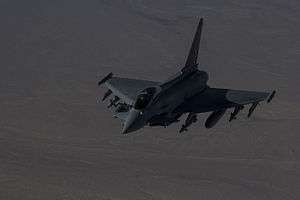 A Typhoon FGR4 flies over Iraq on 22 December 2015. | |||||||
| |||||||
| Belligerents | |||||||
|
|
| ||||||
| Commanders and leaders | |||||||
|
(from 2019) (until 2019) (until 2019) (until 2017) |
| ||||||
| Units involved | |||||||
|
|
| ||||||
| Strength | |||||||
| See Deployed forces | |||||||
| Casualties and losses | |||||||
|
3 servicemen killed (1 non-combat)[9][10][11] 2 servicemen wounded[12] 8 volunteer SDF fighters killed[13] 2 volunteer aid workers executed[14] 1 journalist missing[15] | 4,013 killed, 302 injured (per UK)[16] | ||||||
By January 2019, the Ministry of Defence stated that 1,700 British airstrikes had killed or injured 4,315 enemy fighters in Iraq and Syria, with one civilian causality.[20] The Royal Air Force had also delivered £230 million worth of humanitarian aid.[21] Overall, the operation had resulted in a net cost of £1.75 billion.[22] The number of airstrikes carried out in Iraq and Syria has been described as "second only to the United States".[23][24]
Background
In 2014, the militant group Islamic State of Iraq and the Levant (ISIL) made vast territorial gains in Iraq and Syria following several offensives. It claimed its captured territory a caliphate within which it enforced a strict interpretation of Sharia. The group, which was designated a terrorist organisation by the United Nations, received universal condemnation for its human rights abuses and crimes against humanity. The Iraqi government formally requested the United States to carry out airstrikes against ISIL in support of their fight on the ground.[25] During the 2014 NATO summit in Wales, U.S. Secretary of State John Kerry pressed Ministers of Australia, Canada, Denmark, France, Germany, Italy, Turkey and the United Kingdom to support a coalition to combat ISIL militarily and financially.[26][27] The United States launched the Combined Joint Task Force – Operation Inherent Resolve on 17 October with the stated aim of degrading and destroying ISIL.
Iraq
Humanitarian aid and surveillance
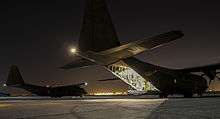
On 9 August 2014, following the genocide of Yazidis and other ethnic minorities by ISIL in Northern Iraq, the British government deployed the Royal Air Force to conduct humanitarian aid airdrops. The first airdrop was conducted on 9 August, with two Lockheed C-130 Hercules aircraft, flying from RAF Akrotiri in Cyprus, airdropping bundles of aid into Mount Sinjar.[28][29] A second airdrop on 12 August had to be aborted due to a perceived risk of injury to civilians.[30] The airdrops were able to resume within 24 hours and two large consignments of aid were airdropped over Mount Sinjar.[31] During the same day, the Ministry of Defence announced the deployment of Tornado GR4 strike aircraft to help coordinate the airdrops using their LITENING III reconnaissance pods; they were not authorized to conduct any airstrikes prior to Parliamentary approval.[32] Four Chinook transport helicopters were also deployed alongside them to participate in any required refugee rescue missions.[33] On 13 August 2014, two C-130 Hercules aircraft dropped a third round of humanitarian aid into Mount Sinjar.[34] This was followed by a fourth and final round on 14 August, bringing the total number of humanitarian aid airdrops conducted by the RAF to seven.[35] The UK suspended its humanitarian aid airdrops on 14 August 2014 due to the "improved humanitarian situation" in Mount Sinjar.[36]
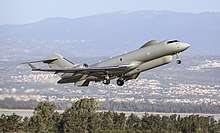
On 16 August 2014, following the suspension of humanitarian aid airdrops, the RAF began shifting its focus from humanitarian relief to surveillance. The Tornado GR4s, which were previously used to help coordinate humanitarian aid airdrops, were re-tasked to gather vital intelligence for anti-ISIL forces. A RC-135 Rivet Joint signals intelligence aircraft was also deployed on what was the type's first operational deployment since entering service.[37] The aircraft was based at RAF Al Udeid in Qatar alongside American aircraft.[38][39] In addition to Tornado and Rivet Joint, the RAF also deployed Reaper, Sentinel, Shadow and Sentry aircraft to fly surveillance missions over Iraq and Syria.[40][41][42]
When asked whether the country would participate in airstrikes or send ground troops, Defence Secretary Michael Fallon stated: "We have not been asked to commit either combat troops on the ground – and we are not going to do that – and we have not been asked to join in other air strikes though we certainly welcome [them]".[43]
Parliamentary approval
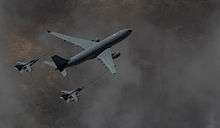
On 20 September 2014, Iraq presented a letter to the UN Security Council (of which the United Kingdom is a permanent member) calling for military assistance in its fight against ISIL, echoing calls they made at the Paris conference on 15 September.[44]
On 26 September 2014, Prime Minister David Cameron recalled Parliament to debate the authorisation of British airstrikes against ISIL in Iraq. Cameron insisted that intervention, at the request of the Iraqi government, to combat a "brutal terrorist organisation" was "morally justified". He went on to state that ISIL was a "direct threat to the United Kingdom" and that British inaction would lead to "more killing" in Iraq. Following a seven-hour debate, Parliament voted overwhelmingly in favour of airstrikes, with 524 votes in favour and 43 against.[45][46] The 43 ‘No’ votes came from 23 Labour MPs, six Conservative MPs, five Scottish National Party MPs, three Social Democratic and Labour Party MPs, two Plaid Cymru MPs, one Liberal Democrat MP, one Green Party MP, and one Respect Party MP.[45] Following the vote, Defence Secretary Michael Fallon told the BBC that the priority would be to stop the slaughter of civilians in Iraq, and that the UK and its allies would be guided by Iraqi and Kurdish intelligence in identifying targets.[45]
Airstrikes
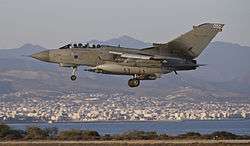
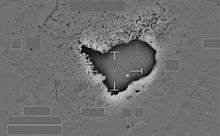
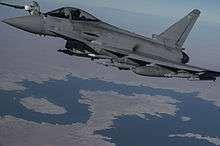
The Royal Air Force began conducting armed sorties over Iraq immediately after parliamentary approval, using its six Tornado GR4s stationed at RAF Akrotiri in Cyprus.[47] The first airstrike took place on 30 September 2014, when a pair of Tornado GR4s attacked an ISIL heavy weapons position using a Paveway IV laser-guided bomb and an armed pickup truck using a Brimstone missile. The Ministry of Defence began publishing a chronological list of all airstrikes conducted in the country, which it made available to view online.[48]
On 3 October 2014, the six Tornado GR4s were bolstered by an additional two aircraft, bringing the total number of combat aircraft supporting the operation to eight.[49] During the same day, it was reported that the Royal Navy had tasked Type 45 destroyer HMS Defender to escort the U.S. Navy aircraft carrier USS George H.W. Bush (CVN-77) whilst the ship launched aircraft into Iraq and Syria.[17]
On 16 October 2014, the Ministry of Defence announced the deployment of an undisclosed number of MQ-9 Reaper unmanned combat aerial vehicles to assist with surveillance.[50] Defence Secretary Michael Fallon stated that the Reapers could also conduct airstrikes alongside the Tornado GR4s, if needed.[50] The first airstrike conducted by a Reaper occurred on 10 November 2014.[51] By 26 September 2015, a full year after the operation first began, Tornado and Reaper aircraft had flown over 1,300 missions against ISIL and had conducted more than 300 airstrikes, killing more than 330 ISIL fighters.[1][52][53]
According to Fallon, the UK had conducted a "huge number of missions" over Iraq by 13 December 2014, a number which was "second only to the United States" and "five times as many as France".[24] By 5 February 2015, the UK had contributed 6% of all coalition airstrikes in Iraq – a contribution second only to the United States – which the Defence Select Committee nevertheless described as "modest".[54][55]
On 14 March 2017, Forces.net reported that the RAF had conducted more than 1,253 airstrikes in Iraq, a number which remained second only to the United States.[23]
After a nine-month period of no airstrikes, they resumed once again on 10 April 2020 when two Eurofighter Typhoons, together with an MQ-9 Reaper, identified and engaged ISIL forces in Iraq, about 200 km north of Baghdad.[56]
Training mission
In October 2014, the British Government agreed to send 12 members of the 2nd Battalion, The Yorkshire Regiment (2 YORKS) into Irbil to train Peshmerga on how to use UK-supplied heavy machine guns.[57] The number of British troops involved in this training mission eventually rose from 12 to 50 before being bolstered by an additional batch of British troops numbering in the "low hundreds".[24] It was also disclosed that a small team of "combat-ready" troops were sent along with them to provide force protection.[24] By 2016, an additional 30 troops were deployed to train Iraqi forces, which brought the total number of deployed British troops in Iraq to 300.[58] The British Army had also trained over 31,000 Iraqi and Peshmerga fighters.[59]
In 2016, a squadron of up to 80 Royal Engineers was deployed to help construct better training facilities at the Al Asad Airbase.[59] This was followed by a six month deployment of 44 Royal Engineers of 5 Armoured Engineer Squadron, 22 Engineer Regiment to Al Asad Airbase in 2017. This brought the number of British personnel at the base to more than 300 and the total in Iraq to around 600.[60]
In January 2017, the BBC reported that L/Cpl Scott Hetherington died in a "shooting accident" at Camp Taji, Iraq. Hetherington was a member of Blenheim Company, and the Force Protection Platoon, 2nd Battalion Duke of Lancaster's Regiment; he was the first British soldier to die in Iraq in almost eight years. About 150 soldiers from the battalion were being deployed to Iraq for a period of six months, forming part of a 500-strong force being sent to train Iraqi and Kurdish security forces.[9]
Following the Baghdad International Airport airstrike in January 2020, the British Army training mission in Iraq was temporarily suspended due to safety concerns.[61]
In March 2020, a rocket attack on an Iraqi military base, hosting British and American military personnel, resulted in the death of three soldiers, including one Briton. She was later identified as L/Cpl Brodie Gillon of the Royal Army Medical Corps and reservist of the Scottish and North Irish Yeomanry.[62] During the same month, the training mission remained suspended and had been scaled down in response to the COVID-19 pandemic.[63]
Ground support
In 2014, Defence Secretary Michael Fallon disclosed during an interview that members of the 2nd Battalion, The Yorkshire Regiment (2 YORKS) had been deployed on the ground in Irbil to help secure the area for a possible helicopter rescue mission. The battalion, which at the time was the Cyprus-based Theatre Reserve Battalion (TRB) for Operation Herrick in Afghanistan, had left Irbil within 24 hours.[64]
In October 2014, Peshmerga claimed they had received assistance from UK Special Forces.[65]
Syria
Preceding events
Prior to Operation Shader, the House of Commons voted on whether or not take military action against the Syrian Government in response to the Ghouta chemical attack in 2013. The House voted against taking military action — the first time a British government had been blocked from taking military action by Parliament.[66] Whilst the outcome was widely reported as a defeat for Prime Minister David Cameron, a spokesman for the Prime Minister nevertheless stated that he had "not ruled anything out" in relation to airstrikes against ISIL.[67] Cameron later elaborated that there was a case for airstrikes in Syria but conceded that any airstrikes would require another House of Commons vote unless it was to prevent a humanitarian catastrophe.[68]
In 2013, two British aid workers, David Haines and Alan Henning, were kidnapped by armed groups in two separate incidents in Syria whilst carrying out humanitarian aid work. In September 2014, ISIL executed an American hostage and threatened to execute Haines if the United States did not end its military interventions in Iraq and Syria. Prime Minister David Cameron condemned the terrorists and stated the UK would "never give into terrorism", adding that ISIL would "be squeezed out of existence".[69][70] ISIL subsequently released a video of Haines being beheaded by an ISIL executioner — an as-yet unidentified British national which the media named Jihadi John. Cameron reacted by stating: "We will do everything in our power to hunt down these murderers and ensure they face justice, however long it takes."[71] An intense manhunt involving MI5, Scotland Yard and the CIA began in an effort to identify John. In October 2014, John executed Henning in retaliation for the UK carrying out airstrikes in Iraq.[72] John was subsequently identified as Mohammed Emwazi, a Kuwati-born British national who previously lived in London.
In 2014, the Ministry of Defence confirmed that surveillance missions were being flown over Syria by the Royal Air Force, including via MQ-9 Reaper drones based in Cyprus.[73][42] In November, a U.S. drone strike targeted and killed Emwazi in Raqqa with support from the Royal Air Force. Prime Minister David Cameron confirmed his death and stated it was an "act of self-defence" achieved through working “hand in glove, round the clock” with the United States.[74]
In 2015, Cameron made repeated calls for airstrikes in Syria following the 2015 Sousse attacks which were perpetrated by ISIL and left 30 Britons dead. These calls were echoed by the Defence Secretary, Michael Fallon, who claimed that there was an "illogicality" of British forces observing the Iraq-Syria border whilst ISIL did not. Fallon stated that the UK did not need the backing of Parliament to launch airstrikes in Syria but the House of Commons would have the final say.[75] The Prime Minister later stated that the UK was committed to destroying the caliphate in both Iraq and Syria.[76] It later emerged that British pilots were taking part in airstrikes in Syria whilst embedded with U.S. and Canadian forces.[77][78] However, British forces themselves remained committed to surveillance and, by November, its Reaper drones had been responsible for 30% of all coalition aerial surveillance in Syria.[79]
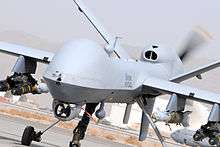
In September 2015, Prime Minister David Cameron announced that two British-born Islamic State fighters, Rayeed Khan and Rahoul Amin, were targeted and killed in Syria by a Royal Air Force Reaper drone. During a statement in Parliament, the Prime Minister explained that it was a "lawful act of self defence" as the two fighters had been plotting attacks against the United Kingdom.[80] The Ministry of Defence later clarified that the strike was not part of Operation Shader.[81]
Airstrikes
In November 2015, following the November 2015 Paris attacks and the adoption of United Nations Security Council Resolution 2249, David Cameron made his first case to Parliament for the UK to conduct airstrikes against ISIL in Syria. He argued that the United Kingdom would be safer by conducting airstrikes and that the UK could not outsource its security to allies. The Prime Minister went on to state that he would not hold a vote on airstrikes until he was sure he could win it.[82][83] In the days following, French President François Hollande and French Defense Secretary Jean-Yves Le Drian made calls for Britain to join airstrikes.[84] This was followed by an appeal from the Russian Ambassador to the UK, Alexander Vladimirovich Yakovenko.[85]
In December 2015, the House of Commons held a ten-hour debate on participating in airstrikes against ISIL in Syria with a final vote. The debate ended with 397 votes in favour of airstrikes and 223 against.[86][87][88] Hours after the vote, four Tornado GR4 strike aircraft left Cyprus and attacked ISIL positions in Syria for the first time, aided by a Voyager aerial refueling tanker and an MQ-9 Reaper drone. The aircraft attacked Omar oilfield in Eastern Syria, one of the largest sources of financial income for ISIL.[51][89] Defence Secretary Michael Fallon subsequently announced that the Royal Air Force would be "doubling its strike force" with six Eurofighter Typhoon multirole fighters and two more Tornado GR4 strike aircraft.[90]
Forces.net reported that as of 14 March 2017, Britain had carried out 85 strikes in Syria, a number second only to the United States.[23]
The Ministry of Defence has published a chronological list of all airstrikes since they began which is available to view on their website.[48]
Training mission
In 2016, a team of 75 British military trainers was deployed to Turkey and other nearby countries in the anti-ISIL coalition to assist with the U.S.-led training programme in Syria. The training programme provided small arms, infantry tactics and medical training to Syrian moderate opposition forces for over three years.[40] Additionally, British forces reportedly helped in the building up of a mechanised battalion in Southern Syria, consisting of tribal fighters to combat Bashar al-Assad's army.[91]
Ground support
In May 2015, surveillance by UK Special Forces had reportedly confirmed the presence of a senior ISIL leader, named Abu Sayyaf, in al-Amr, Syria, after which U.S. Special Operations Forces conducted an operation to capture him. The operation resulted in his death and the capture of his wife Umm Sayyaf.[92] During the same year, UK Special Forces reportedly killed six ISIL fighters during a rescue operation.[93] It was also reported that the UK had supplied anti-ISIL forces with 500,000 rounds of ammunition.[1]
In 2016, The Telegraph reported that UK Special Forces had been operating on the frontline in Syria; in particular in May when they frequently crossed the border from Jordan to support a New Syrian Army unit composed of former Syrian Special Forces defending the village of al-Tanf against ISIL attacks. The New Syrian Army captured the village in that month and faced regular ISIL attacks. British forces also helped rebuild the base following a suicide attack.[94] The New Syrian Army acknowledged that UK Special Forces had provided training, weapons and other equipment; an independent source confirmed that UK Special Forces were operating against ISIL in Syria, Iraq and Libya.[95] In August, BBC News released exclusive images showing UK Special Forces operating in Syria.[96] The pictures, which dated from June, were taken following an attack by ISIL on the New Syrian Army base of Al Tanaf and appear to be showing UK Special Forces securing the base's perimeter.[95][97] UK Special Forces in Syria were reportedly engaged in wide-ranging roles that included surveillance, advisory and combat, in relatively small numbers.[95]
In 2018, a member of UK Special Forces was killed, along with an American soldier, by an improvised explosive device in Syria. This was the first British soldier to die in combat with ISIL.[98]
In 2019, two British special forces soldiers were reportedly injured in an attack carried out by ISIL while supporting the Syrian Democratic Forces' Deir ez-Zor campaign; one Kurd also died.[99]
Libya
On 27 July 2015, David Cameron warned that the UK could intervene militarily in Libya if there was an imminent threat to British lives.[100][101] In August 2015, The Times reported that "hundreds" of British troops were being prepared to deploy to Libya to halt the advance of ISIL.[102]
In December 2015, it reemerged that the government was considering plans to intervene in Libya, following "extreme concern" from the Foreign Office on the rapid rise of ISIL and other extremist groups in Libya.[103] In February 2016, the Royal Air Force had reportedly conducted reconnaissance flights over Libya.[3][104] During the same month, it was widely reported that UK Special Forces were operating in Libya, alongside similar teams from the United States and France.[105][18][106] King Abdullah II of Jordan later announced that British and Jordanian special forces were operating together in Libya.[107] UK Special Forces destroyed an ISIL bomb truck making its way towards Misrata in May 2016.[108]
In March 2016, Defence Secretary Michael Fallon announced that a training team of 20 British troops would be deployed to Tunisia to help guard the Libyan-Tunisian border.[19]
In August 2016, International Business Times reported that British special forces had begun using the XM25 CDTE "Punisher" airburst grenade launcher against ISIL in Libya.[109]
Deployed forces

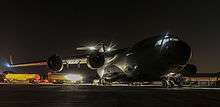
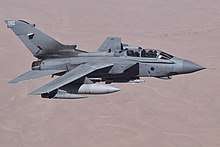
Locations
British Army
The British Army had a total of 1,920 personnel deployed in 2018.[113] This included at least one infantry battalion on a six-month rotation to provide training support and force protection. The units involved have periodically included:
- 2nd Battalion, The Yorkshire Regiment (2 YORKS) (during 2014)[64][114]
- 2nd Battalion, The Princess of Wales's Royal Regiment (2 PWRR) (during 2015)[115][116]
- 1st Battalion, The Rifles (1 RIFLES) (July 2015 – December 2016)[117]
- 4th Battalion, The Rifles (October 2016 – March 2017)[118]
- 2nd Battalion, The Duke of Lancaster's Regiment (2 LANCS) (December 2016 – July 2017)[119][120]
- The Highlanders, 4th Battalion, Royal Regiment of Scotland (4 SCOTS) (July 2017 – December 2017)[121][122]
- The Royal Highland Fusiliers, 2nd Battalion, The Royal Regiment of Scotland (2 SCOTS) (December 2017 – June 2018).[123][124]
- 5 Armoured Engineer Squadron, 22 Engineer Regiment (during 2017)[110]
- 2nd Battalion, The Rifles (2 RIFLES) (July 2017 – January 2018)[125]
- 3nd Battalion, The Rifles (3 RIFLES) (January 2018 – July 2018)[125][126]
- 1st Battalion, Grenadier Guards (June 2018 – November 2018)[127]
- 1st Battalion, Irish Guards (2020)[128]
Royal Air Force
- Headquarters No. 83 Expeditionary Air Group
- No. 903 Expeditionary Air Wing[42][115] at RAF Akrotiri in Cyprus comprising:
- Elements of the RAF Typhoon Force (9 x Typhoon FGR.4 multirole fighter aircraft (6 active, 3 reserve))[129][130]
- Elements of the RAF Lightning Force (6 x F-35B Lightning)[131]
- Elements of the RAF Air Mobility Force:
- 1 x Lockheed C-130 Hercules transport aircraft[34]
- 2 x Voyager KC3 tanker aircraft[132][133][134]
- Elements of the RAF ISTAR Force:
- 2 x Sentinel R1 ISTAR aircraft from No. V(AC) Squadron[40]
- 2 x Sentry AEW1 AEW&C aircraft from No. 8 Squadron[42][135]
- Elements of No. 13 Squadron and No. 39 Squadron (10 x MQ-9A Reaper unmanned combat aerial vehicles stationed in Kuwait)[41][136]
- Elements of No. LXX Squadron (1 x Atlas C1 transport aircraft)[137]
- Elements of No. 99 Squadron (1 x C-17A Globemaster III transport aircraft)[138]
- Elements of No. 51 Squadron (2 x RC-135W Airseeker reconnaissance aircraft stationed at RAF Al Udeid in Qatar)[40][139]
- Elements of No 14 Squadron (1 x Shadow R1 reconnaissance aircraft)[41]
- Elements of the RAF Police
- Elements of No. 51 Squadron RAF Regiment[140]
- Elements of No II Squadron RAF Regiment
Withdrawn assets
- 4 x Chinook HC4 transport helicopters[33] (withdrawn during 2014)[132]
- 1 x Lockheed C-130 Hercules transport aircraft (withdrawn during 2014)[132]
- 8 x Tornado GR4 strike aircraft (withdrawn during February 2019)[32][49][141]
Royal Navy
- Type 45 destroyer HMS Daring
- Between August 2016 to present.[142]
- Type 45 destroyer HMS Duncan
- Type 45 destroyer HMS Defender
- Type 45 destroyer HMS Dauntless
- Type 45 destroyer HMS Diamond
- Since September 2018.[149]
- Type 23 frigate HMS Kent
- Type 23 frigate HMS Richmond[151]
- Type 23 frigate HMS St Albans from December 2015.[152]
- Astute-class or Trafalgar-class Unnamed nuclear-powered attack submarine[153]
- Fort Victoria-class replenishment oiler RFA Fort Victoria[154]
- Sea King ASaC7 helicopters[154]
Tri-Service
Reactions
Domestic
On 26 September 2014, prior to the parliamentary vote on airstrikes in Iraq, Labour Party MP and Shadow Education Minister, Rushanara Ali, wrote to Labour Leader Ed Miliband to announce her resignation as Shadow Minister, in advance of her deliberate abstention in the vote. She wrote that, while acknowledging the "horrific and barbaric" actions of ISIL, she was concerned that British military action would create further bloodshed in Iraq. Rushanara, Bangladesh-born and Muslim, wrote that "there is a genuine belief in Muslim and non-Muslim communities that military action will only create further bloodshed and further pain for the people of Iraq". She added that she had no confidence that the potential impact of such military action on radicalization in the UK had been properly thought through.[157][158]
Anti-war groups, including Stop the War Coalition (StWC), planned a protest march through London on 4 October 2014 in response to Operation Shader. A spokesman of StWC said "All evidence shows that all interventions will just cause more violence". The StWC website argued that the previous two interventions in Iraq had "helped create the current chaos".[159] StWC held another protest in London on 1 December 2015, ahead of the parliamentary vote on airstrikes in Syria.[160]
On 3 December 2015, it was reported that several Labour Party MPs had received death threats and abuse for their support for airstrikes in Syria.[161]
International
The United States welcomed the UK's involvement in the anti-ISIL coalition, with President Barack Obama stating: "Since the beginning of the counter-ISIL campaign the United Kingdom has been one of our most valued partners".[162] Russian Foreign Minister Sergey Lavrov stated he welcomed British airstrikes in Syria, adding "more universal efforts against Islamic State would be more effective".[163] Russian Ambassador to the United Kingdom, Alexander Vladimirovich Yakovenko, made calls for British airstrikes in Iraq.[85]
Islamic State
On 3 October 2014, ISIL executed British aid worker Alan Henning in response to British airstrikes in Iraq.[72] The group has also claimed responsibility for several terrorist attacks, including the 2017 Manchester Arena bombing and Westminster attack, which it claimed were in retaliation for British military action in the Middle East.[164][165][166] In the same year, ISIL also claimed responsibility for the Parsons Green train bombing, with the assailant previously blaming his father's death in Iraq on the UK.[167] ISIL claimed responsibility for the 2020 Streatham stabbing, stating it was in response to its calls to "attack citizens of coalition countries".[168]
Service medal
It was reported that Shadow Defence Secretary Nia Griffith called for a specific award for those who have served in Operation Shader, after visiting troops deployed on the Operation and speaking to armed forces based at RAF Akrotiri. The proposal was submitted for review by the Operational Recognition Board at the Permanent Joint Headquarters.[23]
On 20 September 2017, Defence Secretary Michael Fallon announced that the "Op Shader Medal" will be awarded to those serving in Iraq and Syria. He used the announcement to highlight a lack of recognition for those personnel deployed on the operation, but not located directly within the award criteria; such as Coalition Staff in Kuwait/Turkey and RAF Reaper pilots elsewhere in the Middle East.[169]
Following the announcement, a Defence Instruction and Notice (DIN) was released confirming the eligibility, medal design and production timeline.
The eligibility is 30 Days Continuous Service within the boundaries of Iraq and Syria (45 Days Accumulated) from 9 August 2014[170] to a date yet to be set.
The medal will remain a “Coin”; the same one was used for the medals for Afghanistan and the Congo. The Awards are differentiated by the Ribbon and the clasp (if any). The Ribbons for all iterations of the OSM bear a central group of 5 stripes in light blue, dark blue and red (a broader band in the centre), to represent the 3 Services. These are flanked by a colour specifically chosen to represent the campaign. In the case of the OSM “Iraq & Syria” a recommendation will be made that this outer stripe is Air Superiority Grey, in recognition of the large number of RAF airframes participating in the operation.
Although entitlement has already been agreed, distribution of the medal will not begin until September 2018 due to financial reasons. All 3,600+ outstanding medals from 2014–2018 expected to be received by December 2018.
On 1 July 2018, a pre-release if the OSM (Iraq & Syria) was published by a medal manufacturer, showing the finalised ribbon (MOD Approved) and stating a release date of 18 July 2018. It is expected the full size medals will begin being presentated in line with this date.
On 18 July 2018, Secretary of State for Defence Gavin Williamson presented the Operation Shader Medal, officially known as the Operational Service Medal Iraq and Syria. It has its own distinct ribbon and clasp.[171] He also announced that Her Majesty the Queen had approved an extension to the eligibility criteria for the medal to include personnel outside of the 'conventional area of operations' in Iraq and Syria which would include the Royal Air Force's Reaper crews.[172]
See also
- United Kingdom and ISIL
- Military intervention against the Islamic State of Iraq and the Levant
- Operation Okra – Australian operation against ISIL
- Operation Impact – Canadian operation against ISIL
- Opération Chammal – French operation against ISIL
- Operation Inherent Resolve – US operation against ISIL
- 2018 missile strikes against Syria - The British, French and American strikes against Syria in 2018
References
- "Op Shader – A Year On". Ministry of Defence. 26 September 2015. Archived from the original on 27 September 2015. Retrieved 26 September 2015.
- "Islamic State air strikes: RAF launches Operation Shader". BBC News. 26 September 2014. Retrieved 12 October 2014.
- "RAF flying Libyan missions in preparation for helping unity government". The Guardian. 9 February 2016. Retrieved 25 February 2016.
- "Abu Bakr al-Baghdadi: IS leader 'killed in US operation' in Syria". BBC News. 27 October 2019.
- Engel, Pamela (23 April 2015). "Report: A former physics teacher favored by Osama bin Laden is now leading ISIS". Business Insider. Retrieved 29 April 2015.
- Barbara Starr, U.S. officials say 6,000 ISIS fighters killed in battles, CNN (22 January 2015).
- CIA says IS numbers underestimated, Al Jazeera (12 September 2014).
- https://www.bbc.co.uk/news/uk-32026985
- "L/Cpl Scott Hetherington: UK soldier died 'in shooting accident'". BBC. 3 January 2017.
- "British soldier killed by IED in Syria in first UK troop death in fight against Isil". Telegraph. 30 March 2018.
- "Iraq: British soldier and two US troops killed in 'deplorable' rocket attack on base". Sky News. 12 March 2020.
- Two British special forces soldiers injured by Isis in Syria
- Briton Anna Campbell killed fighting with Kurdish YPJ unit
- Jihadi John's victims: who were they?
- John Cantlie: plea for release of British Isis hostage five years after kidnap
- RAF killed '4,000 fighters in Iraq and Syria'
- "HMS Defender supports operations against ISIL in the middle east". Royal Navy. 3 October 2014. Retrieved 12 October 2014.
- "Libya officials: French special forces on ground fighting IS". Yahoo! News. 25 February 2016. Retrieved 25 February 2016.
- "Britain sends troops to help guard Libya-Tunisia border". DW.com. 1 March 2016. Retrieved 1 March 2016.
- "RAF killed '4,000 enemies in Iraq, Syria'". 7 March 2019. Retrieved 7 March 2019.
- "Iraq crisis: UK humanitarian response factsheet". GOV.UK. Retrieved 7 March 2019.
- Cole, Chris. "Cost of UK Air and Drone Strikes in Iraq and Syria Reach £1.75 Billion." Drone Wars UK. February 02, 2019. Accessed March 08, 2019. https://dronewars.net/2018/02/26/cost-of-uk-air-and-drone-strikes-in-iraq-and-syria-reach-1-75-billion/.
- "'British Troops Fighting IS Should Receive Medal'". forces.net. 14 March 2017.
- "'Hundreds' more UK troops to be sent to Iraq – Michael Fallon". BBC News. 13 December 2014. Retrieved 13 December 2014.
- "Iraq formally asks US to launch air strikes against rebels". BBC News. 18 June 2014.
- ‘NAVO veroordeelt unaniem ‘barbaarse daad’ van Islamitische Staat’ [NATO unanimously condemns ‘barbaric act’]. nrc.nl, 5 September 2014. Retrieved 13 June 2015.
- ‘Verenigde Staten passeren Nederland voor alliantie tegen IS’ [US pass over the Netherlands for alliance against ISIL]. nrc.nl, 9 September 2014. Retrieved 13 June 2015.
- "UK planes to drop emergency aid to Iraqi refugees". BBC News. 9 August 2014. Retrieved 7 October 2014.
- "Iraq aid drops to 'step up', says No 10". BBC News. 10 August 2014. Retrieved 7 October 2014.
Two British C130 cargo planes were involved in dropping off the first batch of supplies.
- "Iraq crisis: RAF aborts air drop amid safety fears". BBC News. 11 August 2014. Retrieved 7 October 2014.
- "RAF planes make second aid drop in northern Iraq". BBC News. 12 August 2014. Retrieved 7 October 2014.
- "Tornados ready to support humanitarian operations". Ministry of Defence. 12 August 2014. Retrieved 7 October 2014.
- "RAF Tornado jets in Cyprus for Iraq aid mission". BBC News. 12 August 2014. Retrieved 7 October 2014.
A "small number" of Chinook helicopters would also be sent for "further relief options", the Foreign Office said.
- "UK steps up aid for Northern Iraq". Ministry of Defence. 13 August 2014. Retrieved 7 October 2014.
- "New UK aid supplies delivered to Iraq". Ministry of Defence. 14 August 2014. Retrieved 7 October 2014.
Over four nights, the UK has successfully delivered a total of seven air drops of clean water, shelter and solar lamps with mobile phone chargers to help thousands of displaced Iraqi people.
- "Iraq crisis: PM calls off aid air drops as 'desperate' situation is made safe". Independent. 14 August 2014. Retrieved 12 October 2014.
- "Iraq: 'Secret' Surveillance Flights Revealed". Sky News. 16 August 2014. Retrieved 12 October 2014.
- "Aviation News – RAF deploys its RC-135 Rivet Joint". Global Aviation Resource. Retrieved 13 December 2014.
- "RAF prepares jets to strike Isis targets in Iraq". The Guardian. 23 September 2014. Retrieved 13 December 2014.
An RAF Rivet Joint surveillance plane equipped with listening devices has also been flying missions from al-Udeid air base in Qatar to eavesdrop on Isis communications.
- "UK troops to train moderate Syrian opposition". Ministry of Defence. 26 March 2015. Retrieved 26 March 2015.
- "RAF steps up Iraq and Syria spying missions in 'new Battle of Britain'". The Guardian. 19 July 2015. Retrieved 19 July 2015.
- "UK details extent of combat activity over Iraq". Flightglobal. 2 March 2015. Retrieved 2 March 2015.
- "UK weighs joining air strikes as RAF drops aid into besieged Iraqi town". The Guardian. 31 August 2014.
- "Letter dated 20 September 2014 from the Permanent Representative of Iraq to the United Nations addressed to the President of the Security Council" (PDF). United Nations Security Council. Retrieved 15 June 2020.
- "MPs support UK air strikes against IS in Iraq". BBC News. 26 September 2014. Retrieved 19 February 2015.
- "Commons recalled to debate Iraq: Coalition against ISIL". UK Parliament. 26 September 2014. Retrieved 1 December 2015.
- "RAF Tornado jets ready for attack role over Iraq". Ministry of Defence. 27 September 2014. Retrieved 12 October 2014.
- "British forces air strikes in Iraq and Syria: monthly list". GOV.UK. Retrieved 17 March 2020.
- "PM announces Tornado deployment". Ministry of Defence. 3 October 2014. Retrieved 12 October 2014.
- "UK deploys Reaper to the Middle East". Ministry of Defence. 16 October 2014. Retrieved 16 October 2014.
- "British forces air strikes in Iraq: monthly list". Ministry of Defence. 3 December 2015. Retrieved 29 November 2015.
- "Islamic State: Military Intervention:Written question – 9798". Parliament. 16 September 2015. Retrieved 17 September 2015.
- "About 330 Isis members killed in RAF airstrikes in past year – MoD". The Guardian. 17 September 2015. Retrieved 17 September 2015.
- "Airwars". Airwars. Retrieved 27 September 2015.
- "Islamic State: MPs urge UK to step up fight against jihadists". BBC News. 5 February 2015. Retrieved 6 February 2015.
- "RAF resumes airstrikes against the Islamic State". Jane's. 26 April 2020.
- "UK troops training Kurdish forces in Iraq, says MoD". BBC News. 12 October 2014. Retrieved 13 December 2014.
- "IS Battle: More UK Troops To Train Iraqi Forces". Sky News. 12 March 2016. Retrieved 12 March 2016.
- "RAF jets busiest for 25 years as they "pound" Isil positions in Iraq and Syria". The Telegraph. 11 December 2016.
- "More British troops head for Iraq to defeat Islamic State". Sky News. 1 September 2017.
- "British Army Training Mission Suspended In Iraq". Forces.net. 5 January 2020. Retrieved 19 March 2020.
- "UK soldier killed in Iraq was 'larger than life'". BBC News. 12 March 2020. Retrieved 19 March 2020.
- "Coronavirus: Britain could see biggest mobilisation of military since Iraq war". Sky News. 25 March 2020. Retrieved 25 March 2020.
- "David Cameron defends 'clear' Iraq strategy". BBC News. 18 August 2014. Retrieved 7 October 2014.
Troops from the 2nd Battalion Yorkshire regiment had been sent into the Kurdish capital Irbil for 24 hours to prepare the ground for a possible rescue mission by the helicopters.
- "More British troops set for Iraq training". The Telegraph. 12 October 2014. Retrieved 2 February 2015.
- Robert Winnett (29 August 2013). "Syria crisis: No to war, blow to Cameron". Daily Telegraph. Retrieved 1 January 2014.
- "David Cameron overrules Philip Hammond on air strikes in Syria". The Guardian. 11 September 2014. Retrieved 18 February 2015.
- "Cameron: IS threat may require Syria intervention". BBC News. 26 September 2014. Retrieved 21 October 2014.
- 'Isis will be squeezed out of existence, says David Cameron'. The Guardian, 3 September 2014. Retrieved 31 October 2014.
- "PMQs: Cameron on Sotloff killing and Islamic State". BBC News. 3 September 2014.
- 'ISIS executes British aid worker David Haines; Cameron vows justice'. CNN, 14 September 2014. Retrieved 31 October 2014.
- "ISIS video claims to show beheading of Alan Henning; American threatened". CNN. 4 October 2014.
- "Surveillance missions over Syria confirmed". Ministry of Defence. 21 October 2014. Retrieved 21 October 2014.
- "'High degree of certainty' that US strike killed Mohammed Emwazi". Guardian. 13 November 2015.
- "Consider Syria IS strikes, defence secretary urges MPs". BBC News. 2 July 2015. Retrieved 2 July 2015.
- "UK will help destroy Islamic State, David Cameron tells US". BBC News. 19 July 2015. Retrieved 19 July 2015.
- "Syria air strikes conducted by UK military pilots". BBC News. 17 July 2015. Retrieved 19 July 2015.
- "First British Pilots In Airstrikes Over Syria". Sky News. 17 July 2015. Retrieved 19 July 2015.
- "Lord Hansard text for 26 Nov 2015". HM Government. 26 November 2015. Retrieved 3 December 2015.
- "Two Britons killed in RAF Syria strike, PM tells MPs". BBC News. 7 September 2015. Retrieved 7 September 2015.
- "Ref: FOI2018/02711" (PDF). Ministry of Defence. 23 March 2018.
- "David Cameron says bombing IS in Syria will make UK 'safer'". BBC News. 26 November 2015. Retrieved 26 November 2015.
- "Syria: Prime Minister's written response on offensive British military operations". 26 November 2015. Retrieved 30 November 2015.
- "Commons should back Syria air strikes – President Hollande". BBC News. 27 November 2015. Retrieved 3 December 2015.
- "Russia and Britain should beat Isil as we did the Nazis: together". Telegraph. 27 November 2015. Retrieved 3 December 2015.
- Riley-Smith, Ben; Wilkinson, Michael (3 December 2015). "Syria airstrikes vote: Britain to begin bombing within hours after MPs overwhelmingly back action – live". The Telegraph. Retrieved 3 December 2015.
- "Syria air strikes: MPs authorise UK action against Islamic State". BBC News. 2 December 2015. Retrieved 3 December 2015.
- "MPs approve motion on ISIL in Syria". UK Parliament. 2 December 2015. Retrieved 5 December 2015.
- "Syria air strikes: What you need to know". BBC News. 3 December 2015. Retrieved 3 December 2015.
- "RAF Typhoons Join Syrian Bombing Mission". Forces TV. 3 December 2015. Archived from the original on 7 December 2015. Retrieved 3 December 2015.
- "Leaked report: SAS on ground in Libya for months". the telegraph. 25 March 2016.
- "SAS 'took part in Abu Sayyaf Isil raid in Syria'". The Telegraph. 9 August 2015. Retrieved 9 August 2015.
- "SAS hero kills six ISIS fighters by himself despite being 'out-gunned and outnumbered' during terror ambush in Syria". Mirror. 20 September 2015. Retrieved 21 September 2015.
- "British special forces 'operating inside Syria alongside rebels'". The Telegraph. 6 June 2016.
- "Pictures appear to show British special forces on Syrian frontline". the guardian. 9 August 2016.
- "First look at Britain's secretive and lethal force in Syria". BBC News. 8 August 2016.
- "UK special forces pictured on the ground in Syria". BBC News. 8 August 2016.
- "British soldier killed by IED in Syria in first UK troop death in fight against Isil". Telegraph. 30 March 2018.
- "Two British soldiers injured in Islamic State attack in Syria". BBC News. 6 January 2019. Retrieved 25 March 2020.
- "David Cameron says UK military could take action in Syria and Libya 'to protect Britons'". Independent. 27 July 2015. Retrieved 25 February 2016.
- "David Cameron takes the fight to Isil, drafting plans to intervene against jihadists in Libya". Telegraph. 26 July 2015. Retrieved 25 February 2016.
- "Hundreds of UK troops set to help Libya fight advance of Isis". The Times. 1 August 2015. Retrieved 25 February 2016.
- "Britain 'moving towards military action against Isil in Libya'". The Telegraph. 11 December 2015. Retrieved 25 February 2016.
- "Signs grow of new Western urgency to stop Islamic State in Libya". Reuters. 25 February 2016. Retrieved 25 February 2016.
- "SAS deployed in Libya since start of year, says leaked memo". Guardian. 25 March 2016.
- "Secret's out: French special forces, along with U.S., U.K. teams, fighting Islamic State in Libya". The Japan Times. 25 February 2016. Retrieved 25 February 2016.
- "REVEALED: Britain and Jordan's secret war in Libya". Middle East Eye. 25 March 2016. Retrieved 25 March 2016.
- "British special forces praised for stopping IS suicide attack in Libya". BT. 26 May 2016.
- "SAS use prototype 'Punisher' weapon system against Isis in Libya". International Business Times. 7 August 2016. Retrieved 9 August 2016.
- "More British troops head for Iraq to defeat Islamic State". Sky News. Retrieved 3 September 2017.
- "British soldiers finish tour". DVIDS. Retrieved 27 December 2016.
- "Explosive hazards awareness training". DVIDS. 27 December 2016.
- "Operation Shader: All You Need To Know About Britain's Fight Against IS". Forces.net.
- "UK troops training Kurdish forces in Iraq, says MoD". BBC News. 12 October 2014. Retrieved 13 October 2014.
- "Defence Secretary thanks UK military personnel tackling ISIL". Ministry of Defence. 1 March 2015. Retrieved 2 March 2015.
- "New Footage of British Troops Training Peshmerga". Forces TV. 27 January 2015. Archived from the original on 30 January 2015. Retrieved 31 January 2015.
- "Task Group Taji trains Iraqi security forces during combat medical course". DVIDS. 27 December 2016.
- "4 RIFLES Welcomed Home From Iraq". The Military Times. 1 March 2017.
- "2 LANCS Head To Iraq To Train Troops In The Fight Against IS". Forces.net. 5 December 2016.
- "MOD statement following death of soldier in Iraq". MoD. Retrieved 2 January 2017.
- "Ready to rumble with ISIS: Scottish troops to target terror as Highlanders head off to Iraq". Daily Record. Retrieved 25 July 2017.
- "Perth soldier Chris Stewart gets ready for Operation Shader later this month". Perth Gazette. Archived from the original on 10 October 2017. Retrieved 25 July 2017.
- "Fallon Praises Troops Preparing To Join Fight Against Islamic State". Forces TV. Retrieved 25 August 2017.
- "2 SCOTS home from Iraq". British Army. 19 June 2018.
- "3 SCOTS in Iraq". WarfareToday. 22 January 2018.
- "British Troops Return Home After Op Shader Deployment". Forces.net. 19 July 2018.
- "Grenadier Guards receive medals for three operational tours in six months". British Army. 22 March 2019.
- "General Strickland visits 1st Battalion Irish Guards [Image 1 of 4]". DVIDS. 21 February 2020.
- "RAF jets leave Scotland to join Syria action". BBC. Retrieved 3 December 2015.
- "Here are some interesting details about RAF Tornados first air strike on ISIS in Syria". theaviationist.com. 3 December 2015. Retrieved 19 February 2017.
- "UK stealth fighter jets join fight against Islamic State". BBC News. 25 June 2019. Retrieved 19 March 2020.
- AirForces Monthly. Stamford, Lincolnshire, England: Key Publishing Ltd. February 2015. p. 5.
- "What is the UK's military commitment in Iraq?". BBC News. 18 August 2014. Retrieved 7 October 2014.
- "It's WAR: RAF Tornados bomb ISIS strongholds in Syria in two waves just 57 mins after vote". Express. 3 December 2015. Retrieved 3 December 2015.
- "The E-3D Sentry Arrives in RAF Akrotiri". Forces TV. 28 January 2015. Archived from the original on 2 February 2015. Retrieved 28 January 2015.
- "What Happens Next If Airstrikes Go Ahead?". Sky News. 2 December 2015. Retrieved 2 December 2015.
- "Global Gateway" (PDF). Royal Air Force. March 2015.
The first Operational Atlas load was delivered to Op SHADER in Cyprus on 3 Mar – a sign of things to come.
- "RAF Delivers Military Support to Iraq". Royal Air Force. 1 September 2014. Archived from the original on 19 October 2017. Retrieved 7 October 2014.
RAF C-17 aircraft have also transported a range of non-lethal support, to be gifted by the UK to Iraq, to RAF Akrotiri in Cyprus which will be transported on to the Kurdish forces.
- "Oral evidence: UK military operations in Syria and Iraq, HC 106". Defence Committee.
[...] we are sending an additional Air Seeker aircraft into the theatre to improve the surveillance capability that we have.
- "Moray soldiers sent to Middle East to fight Islamic State – Press and Journal". pressandjournal.co.uk. Retrieved 19 February 2017.
- "RAF Tornado jets make final UK return". BBC News. Retrieved 8 February 2019.
- "HMS Daring to join campaign against Daesh". Royal Navy. 29 August 2016. Retrieved 29 August 2016.
- "HMS Duncan joins US Carrier on strike operations against ISIL". Royal Navy. 7 July 2015. Retrieved 10 July 2015.
- "Wildcat shows its teeth during Gulf heat trials". Royal Navy. Retrieved 18 September 2015.
- "HMS Defender comes home for Christmas". The News. 12 December 2014. Retrieved 12 December 2014.
- "HMS Defender returns from Middle East deployment". Royal Navy. 6 July 2016. Retrieved 29 August 2016.
- "HMS Dauntless arrives East of Suez". Royal Navy. 28 January 2015. Retrieved 29 January 2015.
- "Double delight as HMS Dauntless and Kent return to Portsmouth". Royal Navy. Retrieved 15 May 2015.
- "HMS Diamond sails for maritime security mission in the Mediterranean". Royal Navy. 29 September 2018.
- "HMS Kent joins US carrier battle group in the Gulf". Royal Navy. 12 December 2014. Retrieved 12 December 2014.
- "HMS Richmond trains with Indian Navy – Royal Navy". mod.uk. Retrieved 19 February 2017.
- "HMS St Albans deploys on security operations in the Middle East". Royal Navy. 1 December 2015. Retrieved 4 December 2015.
- Nichols, Tristan (26 September 2014). "Royal Navy attack sub already deployed off coast of Iraq". The Herald. Archived from the original on 28 September 2014. Retrieved 4 October 2014.
Oliver Colvile, Tory MP for Plymouth Sutton and Devonport, tabled a question to the Deputy Prime Minister asking about the likelihood of Royal Navy involvement in the campaign. "He said there was already a submarine in the Persian Gulf," Mr Colvile told The Herald.
- "Royal Navy Sea Kings play their part in Daesh air strikes". Royal Navy. 9 February 2016. Retrieved 9 February 2016.
- "British special forces join fighters on Isil front line". Telegraph. 30 September 2014. Retrieved 4 October 2014.
SAS and American special forces are working with Kurdish fighters on the Iraqi front lines as part of a major offensive to push Isil jihadists back and relieve pressure on the besieged Syria town of Kobane, senior Kurdish military officers have disclosed.
- "Hundreds Of British Troops To Be Sent To Iraq". Sky News. 13 December 2014. Retrieved 13 December 2014.
The UK government has repeatedly insisted that any such training mission would not constitute 'boots-on-the-ground' although British Special Forces are operating in the region.
- 'As it happened: Commons debate on Iraq airstrikes'. The Times, 26 September 2014. Retrieved 29 October 2014.
- 'Rushanara Ali resigns as shadow education minister over vote on Iraq military action'. Bdnews24.com, 26 September 2014. Retrieved 29 October 2014.
- "'Iraq III No!' Anti-war activists call London protest against UK airstrikes". RT. 3 October 2014. Retrieved 19 February 2015.
- "'Stop The War Coalition' Holds An Emergency Protest In London Ahead Of Commons Syria Vote". Huffington Post. 1 December 2015. Retrieved 3 December 2015.
- "Labour MPs receive death threats and abuse over Syria airstrikes". ITV News. 3 December 2015. Retrieved 3 December 2015.
- Hjelmgaard, Kim (2 December 2016). "British Parliament approves airstrikes against ISIL in Syria". USA Today.
- "British bombers hit ISIS oilfields in Syria hours after parliamentary vote". 2 December 2015. CBC.
- "ISIS Claims Responsibility for Manchester Concert Terrorist Attack". Time. 23 May 2017.
- "Last message left by Westminster attacker Khalid Masood uncovered by security agencies". Independent. 27 April 2017.
- "Isil supporters cheer Westminster attack as 'revenge' for British air strikes on Syria". Telegraph. 22 March 2017.
- "Parsons Green Tube bombing: Teenager Ahmed Hassan jailed for life". BBC News. 23 March 2018.
- "ISIS claims responsibility for Streatham terror attack carried out by Sudesh Amman". Evening Standard. 3 February 2020.
- "Defence Secretary recognises UK efforts in the fight against Daesh with service medal". Gov.uk. 20 September 2017.
- the date of the first HADR drop into Sinjar.
- "New medal unveiled to recognise the fight against Daesh". Gov.uk. 18 July 2018.
- "Drone Crews To Receive New Operation Shader Medal". Forces Network. Retrieved 22 July 2018.